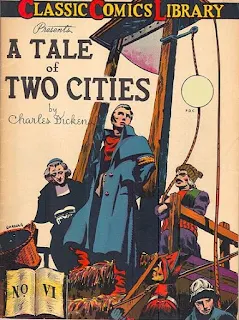Dickens Attitude Towards The French Revolution as Depicted in "A Tale of Two Cities"
The French Revolution was an influential period of social and political upheaval in France that lasted from 1789 until 1799. During this period French citizens razed and redesigned their country’s political landscape uprooting centuries old institutions such as absolute monarchy and the feudal system. The famous slogan of the French Revolution was ‘liberty, equality, fraternity’.
Dickens uses the French
revolution as the background to his novel ‘A tale of Two Cities’. The novel is
set in England and France in 1775. The age is marked by competing and
contradictory attitudes. In England the public worries over religious
prophecies popular paranormal phenomena in the form of ‘the Cock-lane ghost’
and the messages that a colony of British subjects in America has se3nt to king
George III. France on the other hand witnesses excessive spending and extreme
violence a trend that anticipates the erection of the guillotine. In both
countries the poor were exploited by the rich.
In the novel, Dickens points
out the causes of the revolution through the character of the Marquis who is
very cruel. He imposes heavy taxes on the poor villagers who don’t have the
money to buy food or care for their children because they are sending all of
their money to the Marquis. He has no pity for the poor. While returning from
Monseigneur’s party his carriage runs over a small child at Saint Antoine. When
the father of the child Gaspard charges at the carriage he looks at him with
disgust and gives him a gold coin to pay for his dead child. Dickens sets up
the Marquis as a representative of the French aristocracy and a direct cause of
the imminent revolution.
Dickens does not
support revolution. In the novel he has pointed out the violence of the
revolution through the fall of the Bastile and the killing of the governor. The
ghastly aspect of the bloody revolution is hinted at by the hanging of the old Foulon
and his son-in-law by the angry mob. Another aspect is found in the burning of
the chateau the home of the Marquis. The violent aspect of the Revolution is
further stressed in the frightening description of the sharpening of the
weapons by the revolutionaries on the grindstone the terrible account of the
dancing of the Carmagnole the working of La Guillotine and the sentencing to
death of such harmless person as the poor seamstress.
At the end of the novel
after the execution of Carton, Dickens comments on the horror and
meaninglessness of the revolution. He states that revolution is bound to happen
whenever man is crushed oppressed and exploited by the rich. The aristocrats
sow the seeds of the poor return evil for evil. Being tortured and exploited by
the rich the poor are compelled to persecute the aristocracy and other enemies
of the revolution with equal brutality. Through the picture of French
revolution Dickens seems to be warning England that poverty and suffering in
England can also to a revolution like the one in France.
You Can also Read:


Nice 🙂
ReplyDeleteThanks a lot
ReplyDelete